spanish mackerel
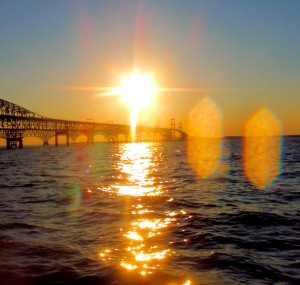 We interrupt this hurricane blog to bring you a fishing report. Yes, this IS a website dedicated to light tackle fishing, and on most Sunday evenings, that’s what I do. I spent most of the day singing the lumberjack song with chainsaw in hand, cutting up the trees and limbs that fell in our yard. After seeing all the trees down around Kent Island today, I’m surprised that we didn’t have more damage than we did. We are also fortunate that the only complete tree that was uprooted in our yard fell harmlessly instead of taking out our picket fence or part of the church next door. We worked on the house and yard most of the afternoon, finishing about 5:00 PM. That left just enough time to go fishing.
We interrupt this hurricane blog to bring you a fishing report. Yes, this IS a website dedicated to light tackle fishing, and on most Sunday evenings, that’s what I do. I spent most of the day singing the lumberjack song with chainsaw in hand, cutting up the trees and limbs that fell in our yard. After seeing all the trees down around Kent Island today, I’m surprised that we didn’t have more damage than we did. We are also fortunate that the only complete tree that was uprooted in our yard fell harmlessly instead of taking out our picket fence or part of the church next door. We worked on the house and yard most of the afternoon, finishing about 5:00 PM. That left just enough time to go fishing.
I launched Thunder Road at Matapeake and ran north to the Bay Bridge. Winds were about 12 knots out of the west when I started, but came down to near zero as the evening wore on. The water was stained, but not as much as I expected. Water temperature and air temperature were exactly the same at 76 degrees. That’s significant because the water has been well into the 80s. It means there was a lot of top-to-bottom mixing due to the storm. I did expect the fish to be freaked out and hunkered down, and they were. I gave the Bay Bridge a good shot, but only caught one little rockfish. I thought the fish might be deep, so I started my fishing trip looking for more of a winter pattern. I marked a few fish deep, but I couldn’t get them to bite. I moved to the shallow pilings and there wasn’t anything going on there either. Read More!
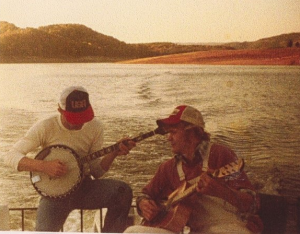 In my book, fishing and music go together like blue crabs and Old Bay seasoning. It’s hard for me to imagine one without the other. I’ve been singing, playing, and writing music for as long as I’ve been fishing. Here’s a shot of me with my best friend Curtis Seals from back around 1979 picking and grinning on the deck of the houseboat I called home. You can’t tell it, but Curtis is steering the outboard with his left foot while he picks his banjo. That takes talent!
In my book, fishing and music go together like blue crabs and Old Bay seasoning. It’s hard for me to imagine one without the other. I’ve been singing, playing, and writing music for as long as I’ve been fishing. Here’s a shot of me with my best friend Curtis Seals from back around 1979 picking and grinning on the deck of the houseboat I called home. You can’t tell it, but Curtis is steering the outboard with his left foot while he picks his banjo. That takes talent!
Many of the songs I’ve penned relate to the water in one way or another. My songwriting has slowed in the past few years because, in my opinion, a good song needs a firm sense of place. After moving away from my home in the Appalachian Mountains to this Chesapeake Bay country, I needed to thoroughly steep myself in the culture before trying to translate local images into songs. A few verses have been showing up in my head lately though, and my old Martin D-18 guitar is coming off the stand a little more frequently than it used to. My son Daniel has a gift for immediately capturing the spirit of the places he visits. He recently turned out a chilling ballad about the ghost of a barge captain who haunts the waters around Cape Charles, Virginia. I’m excited about the song because it’s laced with images of hurricanes, lighthouses, oyster bars, diving gannets, and blitzing rockfish. I hope he’ll record it soon. Read More!
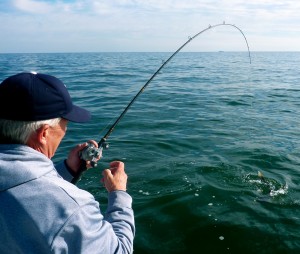 I recently discussed light tackle with some fishing buddies over a bottle of Tennessee’s finest. We all agreed that casting artificial lures on the Chesapeake Bay has the potential to catch as many big fish as any other method. I believe the chances for a trophy striper are better for those who know how to handle a light stick. Until a couple of years ago, most Mid-Atlantic fishermen would have laughed at a statement like that, but not anymore. Throughout 2010, light tackle casting held its own and often out-produced other methods of Chesapeake Bay fishing. It’s encouraging to walk into bait shops and tackle stores now and see Bass Kandy Delights, Bass Assassins, and top water plugs displayed prominently at the end of the aisles beside umbrella rigs and parachute lures. I’m very happy to promote light tackle fishing for one main reason – I don’t know a single light tackle fisherman who isn’t a conservationist. It is absolutely clear that anglers who cast artificial lures are hard-wired to protect the fish and to take care of the water they fish in. Read More!
I recently discussed light tackle with some fishing buddies over a bottle of Tennessee’s finest. We all agreed that casting artificial lures on the Chesapeake Bay has the potential to catch as many big fish as any other method. I believe the chances for a trophy striper are better for those who know how to handle a light stick. Until a couple of years ago, most Mid-Atlantic fishermen would have laughed at a statement like that, but not anymore. Throughout 2010, light tackle casting held its own and often out-produced other methods of Chesapeake Bay fishing. It’s encouraging to walk into bait shops and tackle stores now and see Bass Kandy Delights, Bass Assassins, and top water plugs displayed prominently at the end of the aisles beside umbrella rigs and parachute lures. I’m very happy to promote light tackle fishing for one main reason – I don’t know a single light tackle fisherman who isn’t a conservationist. It is absolutely clear that anglers who cast artificial lures are hard-wired to protect the fish and to take care of the water they fish in. Read More!
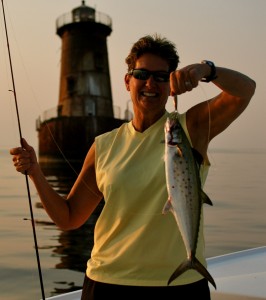 Acelerar, usted está tambaleando demasiado maldito lento. That’s Spanish for “Speed up, you’re reeling too damn slow.” Spanish Mackerel, the fastest fish in the Chesapeake have arrived in good numbers. They’re only in Maryland waters for about a month, but their arrival is something to celebrate.Fishing for Spanish is one of my favorite summer activities. The easiest way to catch them is to troll fast with in-line planers. If I just wanted to put meat in the box, that’s what I’d do. But I prefer to honor these infrequent visitors by targeting them by casting. Mack casting takes Chesapeake Bay fishing to another level. To catch Spaniards you first have to find the blitzing schools of bluefish and stripers, then turn loose of everything you’ve been doing all year, and try not to catch them. Too slow are the words most often heard on Thunder Road when we’re targeting Macks. It means someone onboard has accidentally hooked up a rockfish or a bluefish. When casting for Spanish with light spinning gear, the second most successful cast is one that doesn’t catch a thing.
Acelerar, usted está tambaleando demasiado maldito lento. That’s Spanish for “Speed up, you’re reeling too damn slow.” Spanish Mackerel, the fastest fish in the Chesapeake have arrived in good numbers. They’re only in Maryland waters for about a month, but their arrival is something to celebrate.Fishing for Spanish is one of my favorite summer activities. The easiest way to catch them is to troll fast with in-line planers. If I just wanted to put meat in the box, that’s what I’d do. But I prefer to honor these infrequent visitors by targeting them by casting. Mack casting takes Chesapeake Bay fishing to another level. To catch Spaniards you first have to find the blitzing schools of bluefish and stripers, then turn loose of everything you’ve been doing all year, and try not to catch them. Too slow are the words most often heard on Thunder Road when we’re targeting Macks. It means someone onboard has accidentally hooked up a rockfish or a bluefish. When casting for Spanish with light spinning gear, the second most successful cast is one that doesn’t catch a thing.
Spanish move up the coast from Mexico and Florida in summer months as water temperatures rise. Much more common and easier to catch down south, they reach the Chesapeake Bay in July and August. Some years they come up farther Read More!
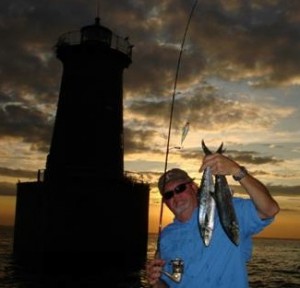 While I haven’t seen any Spanish mackerel flying around the Eastern Bay recently, I was fortunate enough to find a school farther south tonight. I fished onboard Fishadler II with Mark, launching out of Queen Anne Marina on Kent Island. It’s a full moon which usually means increased current, but we haven’t had much incoming tide this week. Fortunately, the outgoing current has been very strong. About 3:00 PM – during the last hour of the outgoing – we found breakers near Sharp’s Island Light and noticed macs in the mix. That’s about seven miles south of where they were last week. Although we had trolling gear on the boat, it looked like there might be enough to catch some casting. I started slinging a homemade three-quarter-ounce inline sinker, flattened and rolled in super-fine blue glitter with a treble hook attached. I think I hooked six or eight macs, but didn’t get them all in the boat. Casting for macs is a different game than trolling for them. Even if you can find them and manage to hook one, getting them to the boat is very challenging. The trick is to keep their nose pointed toward the boat, then sling them up over the side. If they ever turn and head off in the opposite direction, they’re usually gone. Read More!
While I haven’t seen any Spanish mackerel flying around the Eastern Bay recently, I was fortunate enough to find a school farther south tonight. I fished onboard Fishadler II with Mark, launching out of Queen Anne Marina on Kent Island. It’s a full moon which usually means increased current, but we haven’t had much incoming tide this week. Fortunately, the outgoing current has been very strong. About 3:00 PM – during the last hour of the outgoing – we found breakers near Sharp’s Island Light and noticed macs in the mix. That’s about seven miles south of where they were last week. Although we had trolling gear on the boat, it looked like there might be enough to catch some casting. I started slinging a homemade three-quarter-ounce inline sinker, flattened and rolled in super-fine blue glitter with a treble hook attached. I think I hooked six or eight macs, but didn’t get them all in the boat. Casting for macs is a different game than trolling for them. Even if you can find them and manage to hook one, getting them to the boat is very challenging. The trick is to keep their nose pointed toward the boat, then sling them up over the side. If they ever turn and head off in the opposite direction, they’re usually gone. Read More!
 “There is but one entrance by Sea in this County, and that is at the mouth of a very goodly Bay, 18 or 20 myles broad…. Within is a country that may have the prerogative over the most pleasant place ever knowne, for large and pleasant navigable Rivers. Heaven and earth never agreed better to frame a place for man’s habitation…” – Captain John Smith, 1608 ♣ I first heard the Chesapeake region called “The Land of Pleasant Living,” when I read it on the side of a Natty Boh can. I didn’t know at the time that the phrase goes all the way back to the 17th century explorations of Captain John Smith. While I might disagree with the good captain during the frozen days of February, there’s no doubt that August brings out the very best of the Bay he called, “Chesepioc.” Read More!
“There is but one entrance by Sea in this County, and that is at the mouth of a very goodly Bay, 18 or 20 myles broad…. Within is a country that may have the prerogative over the most pleasant place ever knowne, for large and pleasant navigable Rivers. Heaven and earth never agreed better to frame a place for man’s habitation…” – Captain John Smith, 1608 ♣ I first heard the Chesapeake region called “The Land of Pleasant Living,” when I read it on the side of a Natty Boh can. I didn’t know at the time that the phrase goes all the way back to the 17th century explorations of Captain John Smith. While I might disagree with the good captain during the frozen days of February, there’s no doubt that August brings out the very best of the Bay he called, “Chesepioc.” Read More!


